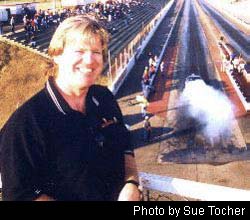|

5/7/04
HOW DO I LOVE
THEE?

 n
the surface, heads-up drag racing is about the
simplest motorsport on the planet. You get the
signal to go, race side-by-side to a pre-determined
point, and whoever gets there first is declared
the winner. There are no pit strategies, no
interpretations of out-of-bound rules, no caution
laps, and no mileage races. It’s a contest
of speed, pure and simple. n
the surface, heads-up drag racing is about the
simplest motorsport on the planet. You get the
signal to go, race side-by-side to a pre-determined
point, and whoever gets there first is declared
the winner. There are no pit strategies, no
interpretations of out-of-bound rules, no caution
laps, and no mileage races. It’s a contest
of speed, pure and simple.
Well, we all know there’s a little more
to it than that, but the original premise never
changes. Which begs the question, how many times
do you need to watch that? Beyond the noise
and speed, what’s the recurring attraction?
I mean, what’s the big deal with drag racing?
I have to admit there’ve been times when
I’ve questioned my own devotion—usually
about midnight after it’s been raining
all day, the track’s just been oiled for
the sixth time that weekend, and I’m facing
a four-hour drive to get home before going to
my “real” job in the morning. Gotta’
admit, racing doesn’t seem like such a
great pastime at such moments. And yet, I stay
until the bitter end, take my final-round photos,
do my victory-lane interviews, and know I’ll
be back for the next event. Why? Because I genuinely
love the sport. Hardcore, as the Burkster likes
to say.
But again, there’s more to it than that.
When I think about why I enjoy drag racing,
to a large degree it does stem from the purity
and simplicity of a head-to-head speed contest.
I like the finality of eliminations because
it makes each and every round just as important
as the next. (Try saying that about lap 102
in any NASCAR race.) There is just no opportunity
to dog it in a drag race.
It’s also because each event puts on display
the efforts of its participants: their theories
and inventions; work back at the shop; testing
during off weekends; and most of all, their
dreams, passion, and talents. And even with
the most basic premise, each drag race has the
potential to be unique. How else to explain
so many memorable moments, passes that you still
remember where you were sitting, or even what
the scoreboards displayed when the chutes came
out?
Drag racing also offers up technological marvels
on a routine basis. How about going from a standing
start to more than 330 mph in less than 4.5
seconds? Sure, there’s always an appreciative
buzz when we see something like that, but when
you step back and think about it—really
think about it—it’s quite incredible.
And not even because of the massive power of
a nitro engine; I expect those motors to run
strong. But how does that rear tire not just
break loose every time that power is applied?
Yes, I know it can be explained mathematically,
but so can the angles of Dick LaHaie’s
hair and I think they’re pretty awe inspiring,
too.
It’s not all about the visceral and physical
aspects of drag racing, though. Joe Scheil,
a long-time hot rodder from California, eloquently
expressed a philosophical bent on the sport’s
appeal. “If you put a car on a drag strip,
whether it’s for four seconds or 15 seconds,
you’re risking everything,” he said.
“When that car finishes and comes off clean
and hasn’t been wrecked, even though it
may not have won, that car is suddenly more
honorable because it risked everything and survived.
If you go to a car show people like to look
at restored cars, but they’ll spend more
time looking at a race car. A Dick Landy car
is revered not because it’s a Hemi GTX,
but because it’s a car that has survived
5,000 runs. It’s a warrior and represents
everything you want it to be.”
Truer words were never spoken. I was reminded
of this at a recent Outlaw 10.5 race when a
competitor slapped the wall, causing mostly
cosmetic damage to the flank of his car. No
matter, a large crowd gathered when he returned
to his pit, and this car that no one had paid
any particular attention to when it came off
the trailer was suddenly one of the stars of
the meet. It had raced and survived, albeit
a little worse for wear, and everyone wanted
to see the battered warrior.
Perhaps the greatest attraction of drag racing,
though—or any racing, for that matter—is
the likelihood of a good story. Like a great
movie or novel, a great race involves heroes
and villains, thrilling and poignant moments,
intense rivalries and displays of sportsmanship.
It inevitably offers excitement, surprises,
disappointment, and triumph. And no matter what,
someone always enjoys a happy ending.
Race safe,
P.S. What’s the attraction of drag racing
for you? Is it the accessibility of drivers
and teams? The variety of classes? Potential
for big numbers? Send an e-mail and let us know
what you think is the big deal with drag racing.


|
Previous
Story
|
Tocher
Talks —
4/8/04
Discover your outlaw roots |
|
